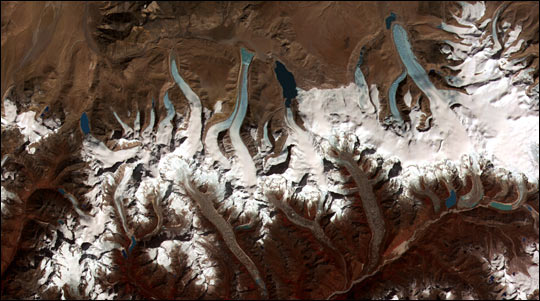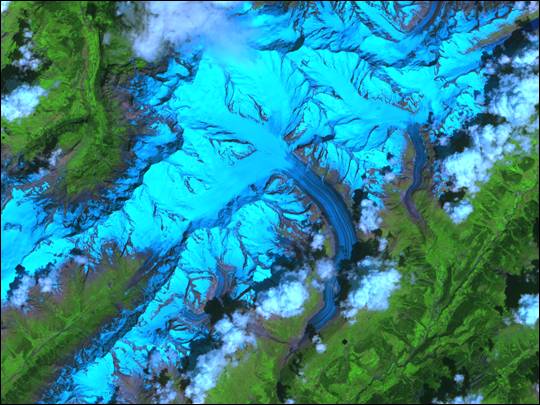

 |
|||
|
Visit the world’s high mountain ranges and you’ll probably see less ice and snow today than you would have a few decades ago. More than 110 glaciers have disappeared from Montana’s Glacier National Park over the past 150 years, and researchers estimate that the park’s remaining 37 glaciers may be gone in another 25 years. Half a world away on the African equator, Hemingway’s snows of Kilimanjaro are steadily melting and could completely disappear in the next 20 years. And in the Alps, glaciers are retreating and disappearing every year, much to the dismay of mountain climbers, tourist agencies, and environmental researchers. “Receding and wasting glaciers are a telltale sign of global climate change,” said Jeff Kargel, head of the Global Land Ice Measurements from Space (GLIMS) Coordination Center at the United States Geological Survey (USGS) in Flagstaff, Arizona. Kargel is part of a research team that’s developing an inventory of the world’s glaciers, combining current information on size and movement with historical data, maps, and photos.
In response to climate fluctuations, glaciers grow and shrink in length, width, and depth. Because glaciers are sensitive to the temperature and precipitation changes that accompany climate change, the rate of their growth or decline can serve as an indicator of regional and global climate change. Tracking and comparing recent and historical changes in the world’s glaciers can help researchers understand global warming and its causes (such as natural fluctuations and human activities). Glacial changes can also have a more immediate impact on communities that rely on glaciers for their water supply, or on regions susceptible to floods, avalanches, or landslides triggered by abrupt glacial melt. |
June 22, 2004 Title graphic image: South Cascade Glacier in the Washington Cascade Mountains, in 1928, 1979, and 2000 (Images courtesy of the National Snow and Ice Data Center)
|
||
 |
|||
|
Scientists track glacial change by measuring individual glaciers and comparing their size over time with records of the local and regional climate. But measuring every major glacier on Earth would be a monumental task. Approximately 160,000 glaciers occupy the Earth’s polar regions and high mountain environments, and sending a team to each one every year would be costly and difficult to coordinate. In addition, although a few research teams travel to a few glaciers each year to measure ice depth, size, movement, and water content, the data from individual glaciers don’t necessarily reveal how other glaciers in the same region—much less in other parts of the world—are changing. Even glaciers within the same region can react differently to environmental changes. For example, while most glaciers in Glacier National Park are retreating, some are advancing. The GLIMS team uses high-resolution satellite images from the Advanced Spaceborne Thermal Emission and Reflection Radiometer (ASTER) instrument and the Landsat Enhanced Thematic Mapper Plus (ETM+), archived at the Land Processes Distributed Active Archive Center (LP DAAC), to track the size and movement of glaciers. For the first time, scientists will be able to assess and track glacial change on a global scale through a worldwide database of glacier information. |
This ASTER image shows the lakes left behind by retreating glaciers in the Bhutan-Himalaya. (Image courtesy of Jeffrey Kargel, USGS/NASA JPL/AGU) Click here for more information. |
||
 |
|||
|
More than 100 investigators in 24 countries are helping to build the GLIMS database. “These investigators collect and analyze satellite images of the glaciers in their own region, such as the Alps or the Andes, and then send their analyses and results to the Coordination Center for inclusion in the GLIMS database,” Kargel explained. The researchers also compare the satellite images with historical maps and information to determine a glacier’s advance or retreat over the past few decades. Satellite imagery can help reveal short- or long-term trends in glacier activity that could impact water supplies or cause glacial hazards.
About three-quarters of the Earth’s fresh water is held in ice sheets and mountain glaciers, so recognizing glacial changes is crucial to monitoring water supplies. “Glaciers serve as a natural regulator of regional water supplies,” said Kargel. During periods of warm weather and intense sunlight, such as during dry seasons and droughts, glaciers melt vigorously and provide a water source for the surrounding ecosystems and communities. Conversely, during cold, rainy seasons, glaciers produce less meltwater. “Glacier changes, especially recent melting, can affect agriculture, drinking water supplies, hydroelectric power, transportation, tourism, coastlines, and ecological habitats,” he added. |
This ASTER image, acquired on July 23, 2001, shows Aletsch Glacier, the largest glacier of Europe. (Image by Earth Observatory Team, based on data provided by the ASTER Science Team) |
||
|
In areas with very large glaciers, increased melting could result in temporary increases in meltwater available for human use. But as the world’s glaciers continue to melt and shrink, over time there will be less water to sustain the communities that have come to depend on that meltwater. In Kazakhstan, for example, glaciers feed many of the rivers used for agricultural irrigation, and the recent glacial retreat in that region is now compromising the area’s water supply. “It’s kind of like a bank account—when you’ve withdrawn all the water, there isn’t any more,” said Kargel. Excessive glacial melt can also result in increased hazards or disasters for communities living near glaciers. “Glaciers don’t always behave nicely. They’re a type of natural reservoir with a temper, in some cases. Some glaciers have a nasty habit of storing up large amounts of water and then releasing it suddenly in a massive melt or calving episode, which may involve floods, landslides, or avalanches,” said Kargel. As settlements, farming, and tourism extend toward the edges of glaciated regions, melting glaciers and the avalanches and floods that often accompany rapid melt increasingly threaten lives and infrastructure in mountain regions. The ASTER images acquired for the GLIMS project allow researchers to recognize and track changes in glacial hazard indicators such as crevasses, avalanche and debris-flow traces, and glacial lakes. While current melting trends can’t be slowed or reversed, the information collected through the GLIMS project will enable researchers to better understand the relationship between climate and glaciers, and to better predict areas of future glacier changes.
The ASTER images of each glacier, along with the data collected and analyzed by the GLIMS team, are stored in a large database jointly developed by the USGS in Flagstaff and the National Snow and Ice Data Center (NSIDC) in Boulder, Colorado. Previous glacier databases stored information such as location, length, orientation, type, and altitude for one point near the center of each glacier. “The GLIMS database will store detailed information for the entire outline of each glacier, providing more complete spatial data,” said Bruce Raup, technical lead for the GLIMS project at NSIDC. “As the data become available in the database, users will be able to do online searches and see the resulting data in multiple formats, including views of glacier extent and elevation superimposed on ASTER images.” |
This composite ASTER image shows how the Gangotri Glacier terminus has retracted since 1780. Contour lines are approximate. (Image by Jesse Allen, Earth Observatory; based on data provided by the ASTER Science Team; glacier retreat boundaries courtesy the Land Processes Distributed Active Archive Center) |
||
 |
|||
|
One of the challenges of the GLIMS glacier inventory is the accurate identification of each glacier. “While it may seem easy to define what a glacier is, it can be quite difficult to identify individual glaciers in highly glacierized areas where the glaciers branch or run together,” said Raup. Also, recent glacial melt has resulted in some dramatic glacial changes; for example, some large Y-shaped glaciers that are numbered and described in the older World Glacier Inventory have recently shrunk into two separate ice masses. “We’re currently creating protocols that enable us to draw accurate boundaries around individual glaciers and properly classify glaciers that previously were part of other glaciers,” Raup added. This process will help identify the extent to which large, glacierized areas have become smaller and more fragmented. Although the GLIMS project is still in a formative stage, the yearly satellite data being compiled and stored with historical data from the last three to five decades will enable scientists to track worldwide glacier changes and the effects of such change on surrounding communities and habitats. “I think we’ll have some interesting data that will be publicly accessible within the coming year,” said Raup. “It won’t be global coverage yet, but there should be some good snapshots of glacier health within a few regions. This is a fascinating time to study and inventory the world’s glaciers because of the recent dramatic changes.”
“I think a hundred years from now, the GLIMS effort to study the world’s glaciers will still be going strong,” said Kargel. “There will still be glaciers to study, although far fewer than there are today. But GLIMS will eventually consist of well over a century’s worth of glacial data.” |
Left: This 1929 photograph shows Taku Glacier as it winds through the mountains of southeastern Alaska, calving small icebergs into Taku Inlet. (Image courtesy of U.S. Navy) |
||
|
For more information: |
||